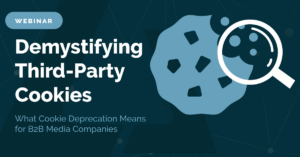Outsourcing to CDP vendors to help with data organization and integration is the industry-leading way of reaching wider audiences with personalized content in our modern world, where online privacy is advocated for and demanded by the masses. Since third-party cookies are getting phased out per domestic and international legislation (more on that later), first-party data is the new face of how data should be used and activated to reach customers and prospects. Below is Leverage Lab’s list of questions you should ask CDP vendors before signing on with them.
What key goals do we have in mind for this platform pick/switch?
It is important to take into consideration the long-term goals along with the detailed ones to make sure that they work in tandem with each other when deciding on a CDP vendor. Further, groundbreakers in the industry have voiced their praises for CDP platforms and their data implementation, prompting many others to consider jumping on the wagon; adjusting their data implementation to reach more prospects and attain more customers. Knowing what goals you already have in mind for your company can help you ask the right questions when trying out new vendors, enabling them to better customize solutions to your company’s specific needs and overall goals. So, when thinking through these steps, you should already have an idea of why and how you plan on using CDP to meet your company’s goals.
How secure is your CDP platform?
You will inevitably be storing your customer data somewhere, and knowing which CDP vendor has reliable security can help both your company and customers sleep better at night. As international and domestic legislations swoop through nations such as Europe’s General Data Protection Regulation (GDPR) and the California Consumer Privacy Act (CCPA), marketers are aware that they will be gazed upon under watchful eyes with how data is handled. That’s why it is important to protect your company and your customers’ data when sharing them with your CDP partner, because any failure of theirs will be reflected onto your company’s in your customers’ eyes, regardless of who is at fault. Aim for CDP vendors who have security features that will help you comply with established security and privacy laws to the CCPA and GDPR, and if they don’t have it, that is a strong disqualifying factor in our modern online privacy-regulatory climate. Make sure you understand your CDP vendor’s security before signing up to avoid putting your customer data at risk.
What major pain points should this solution alleviate?
To have a CDP platform is like creating a harmonic convergence between your marketing team and your data science team. With this in mind, the platform should eliminate common roadblock problems like lag times from obtaining data and insight from analysts to your marketers, incomplete or siloed customer data, and lag during real-time personalization. Of course, these are just some of the pain points that can be found along the way, but it is important to find a solution that is tailored to eliminate them, thus improving your customers’ experiences.
Does the CDP allow marketers to access and act on raw data customer data and raw data without IT assistance?
To unveil key moments along the customer journey, raw data needs to be easily accessible to marketers, and without IT assistance (more on that later). Average and aggregate numbers only tell a fraction of the story, thus access to raw, unfiltered data is crucial. You should also ask if the platform supports raw data access through a GUI, API, or SQL. Being able to do ad hoc queries shouldn’t be problematic, as well as adding data and fields to your data, should not incur extra charges relating to data warehouse redesign or access.
In terms of allowing marketers access to CDP data as well as raw and unfiltered data without IT assistance, this is potentially one of the most important aspects of CDPs that improves efficiency, eliminating the need for marketers to wait for IT assistance from various touchpoints. Not only can this be frustrating for marketers who want to execute simple tasks, but it produces lag in workflows and more pain points. Knowing ahead of time how you will be accessing your customer data, whether unified or raw and unfiltered, should be on top of your list of questions to ask your CDP vendor.
Can the system properly ingest data from a variety of sources, such as all your product and data and catalog, in addition to your customer data? And if so, does it have ready-built connectors for common martech tools used for data input and activation?
An important aspect of CDP is its ability to absorb all of your customer data ranging from ERP systems, POS systems, weblogs or app data, data lakes or warehouses, or those that are housed in SaaS tools such as CRM, martech automation, or customer loyalty programs. With that in mind, CDPs should be able to connect with most systems through pre-built connectors and also have the flexibility to create custom integrations. Also, a good CDP should be capable of accessing wide-ranged data. Obtaining all of your data in one place allows for ease of activation as well as improving the performance of identity resolutions, helping to reduce duplicate profiles and acquiring a holistic, 360-degree view of each customer.
Bonus Question: How can we execute on a larger customer-centric strategy that includes 1-to-1 personalization or recommendations at every relevant touchpoint along the customer journey?
Most major CDP solutions have functionality that allows for personalization on website or email channels, but most customer journeys include many more crucial customer engagement points. So, it’s important to think, how can you leverage CDP data along with other third-party data like location and weather to orchestrate a more comprehensive recommendation strategy?















